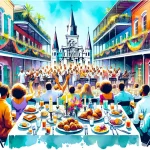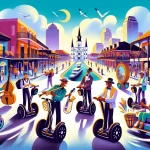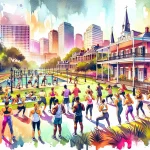Situated in New Orleans, the French Quarter is a captivating blend of history, culture, and vibrant energy. This iconic neighborhood, locally known as the Vieux Carré, offers an authentic taste of the city’s rich heritage and joie de vivre, making it a must-visit destination.
In This Article
TL;DR
- Explore iconic sites like Jackson Square, Bourbon Street, and Royal Street.
- Indulge in the delectable Cajun and Creole cuisine, including gumbo, jambalaya, and beignets.
- Immerse yourself in the unique blend of French, Spanish, and Creole cultures through architecture and museums.
Iconic Landmarks and Streets
Jackson Square
Jackson Square, a historic park at the heart of the French Quarter, is a cultural hub that captures the essence of New Orleans. Surrounded by iconic buildings like the St. Louis Cathedral, the Cabildo, and the Pontalba Apartments, this picturesque square is a living museum showcasing the city’s diverse influences.
The St. Louis Cathedral, dating back to the 18th century, exemplifies French and Spanish colonial architecture with its towering spires and intricate facade. This iconic landmark has witnessed countless historical events and remains an active place of worship.
Jackson Square is also a vibrant gathering place for artists, street performers, and fortune-tellers, adding to its lively atmosphere. Visitors can admire local painters’ works, watch mesmerizing street performances, or have their fortunes read by skilled tarot readers.
Bourbon Street
Bourbon Street, the heart of New Orleans’ legendary nightlife, is a must-visit destination for those seeking a taste of the city’s festive spirit. This iconic street, lined with bars, clubs, and live music venues, comes alive at night with the sounds of jazz, blues, and revelry.
While Bourbon Street is known for its lively atmosphere, it also offers a glimpse into the city’s rich musical heritage. Many bars and clubs feature live performances by talented local musicians, allowing visitors to experience the authentic sounds of New Orleans.
To embrace the Bourbon Street experience fully, visitors are encouraged to explore responsibly, savoring the music, trying local cocktails, and immersing themselves in the vibrant energy that makes this street a symbol of New Orleans’ joie de vivre.
Royal Street
For those seeking a refined and artistic experience, Royal Street is a true gem. This charming street is a haven for art lovers and antique seekers, offering galleries, boutiques, and shops showcasing the city’s creative spirit.
From local artists’ paintings and sculptures to antique stores brimming with unique finds, Royal Street is a treasure trove for those seeking one-of-a-kind pieces. Visitors can spend hours exploring the eclectic offerings, discovering hidden gems, and immersing themselves in New Orleans’ artistic soul.
Royal Street’s atmosphere contrasts with Bourbon Street’s lively energy, offering a quieter and more refined ambiance that allows visitors to appreciate the city’s finer cultural aspects.
Culinary Delights of the French Quarter
Cajun and Creole Cuisine
New Orleans is renowned for its rich culinary heritage, and the French Quarter is the epicenter of this gastronomic adventure. The city’s cuisine is a unique blend of Cajun and Creole influences, each with distinct flavors and traditions.
Cajun cuisine, rooted in Louisiana’s rural bayou regions, is known for hearty dishes like gumbo, jambalaya, and étouffée, showcasing bold and rustic flavors. Creole cuisine, influenced by French, Spanish, and African cultures, is characterized by refined techniques and complex flavors, featuring dishes like shrimp remoulade, turtle soup, and bananas Foster.
Visitors can indulge in these culinary delights at various restaurants, each offering unique interpretations of these iconic dishes. From hole-in-the-wall joints to upscale establishments, the neighborhood is a true paradise for food lovers.
Iconic Eateries
No visit to the French Quarter would be complete without experiencing some of its legendary eateries. These iconic establishments have stood the test of time, serving as guardians of the city’s culinary traditions and offering a taste of history with every bite.
Café du Monde, a beloved institution since 1862, is renowned for its beignets – pillowy squares of fried dough generously coated in powdered sugar. This iconic café offers an authentic New Orleans experience, best enjoyed with a steaming cup of café au lait.
Another culinary landmark is Antoine’s, serving Creole cuisine since 1840 and one of the oldest family-run restaurants in the United States. This historic establishment is renowned for classic dishes like Oysters Rockefeller and Baked Alaska, offering a glimpse into the city’s rich culinary heritage.
Visiting these iconic eateries is about immersing oneself in the history and traditions that have shaped New Orleans’ culinary landscape.
Food Tours and Cooking Classes
For a more immersive culinary experience, the French Quarter offers food tours and cooking classes. These guided experiences provide an opportunity to explore the city’s rich food culture, learn about its history, and even try preparing local dishes.
Food tours, led by knowledgeable guides, take visitors on a gastronomic journey through the neighborhood’s iconic eateries, sampling local specialties and learning about the stories and traditions behind each dish.
Cooking classes, on the other hand, offer a hands-on experience where participants can learn techniques and secrets of New Orleans’ cuisine from experienced chefs. These classes provide valuable culinary skills and a deeper appreciation for the city’s culinary heritage.
Cultural and Historical Insights
Museums and Galleries
The French Quarter is a living museum, with its streets and buildings telling stories of the city’s rich history and cultural influences. For a more in-depth exploration, the neighborhood is home to several museums and galleries that offer a deeper understanding of New Orleans’ past and present.
The New Orleans Jazz Museum, located at the heart of the French Quarter, is a must-visit for music enthusiasts. This museum celebrates the city’s iconic jazz heritage, featuring exhibits showcasing the lives and legacies of legendary musicians, as well as interactive displays that allow visitors to experience the rhythms and sounds of this iconic art form.
The Cabildo, a historic Spanish colonial building, houses the Louisiana State Museum, offering a comprehensive look at the state’s history, from its indigenous roots to its role in the Civil War and beyond. Visitors can explore exhibits showcasing artifacts, documents, and multimedia displays that bring the past to life.
Additionally, the French Quarter is home to numerous art galleries showcasing the works of local and regional artists, offering a glimpse into the city’s vibrant creative scene.
Architectural Styles
One of the most striking aspects of the French Quarter is its unique architectural blend, reflecting the diverse cultural influences that have shaped the city over centuries. As visitors stroll through the neighborhood’s streets, they’ll encounter a harmonious fusion of French, Spanish, and Creole architectural styles.
The iconic Creole townhouses, with their distinctive wrought-iron balconies and colorful facades, are a quintessential feature. These narrow, multi-story buildings were designed to maximize living space while providing natural ventilation and shade from Louisiana’s hot sun.
Spanish colonial architecture is prominently featured, with buildings like the St. Louis Cathedral and the Cabildo showcasing the ornate and imposing styles of that era. Additionally, elements of French architecture can be seen in the intricate ironwork, courtyards, and symmetrical designs of many buildings.
This architectural diversity adds to the charm and beauty of the French Quarter and serves as a tangible reminder of the city’s rich cultural tapestry, where different influences have blended seamlessly over time.






